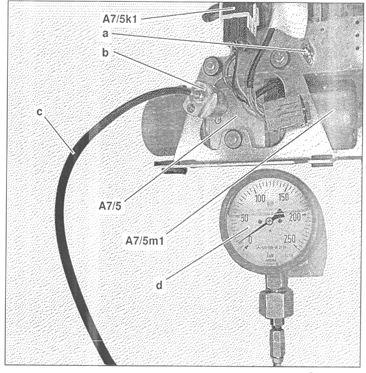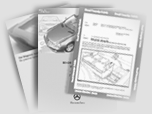
Diagnostic Manual, Body and Accessories,
Volume 6
Hydraulic Test Program - Hydraulic Oil Pump Test
Preparation for Test
 CAUTION! CAUTION!
Risk of severe injury, ensure that no persons are within the deployment radius of the roll bar during testing and repair.
Fully extend the roll bar prior to performing any repair work. Keep body parts away from the roll bar deployment radius and its mechanism.
 CAUTION! CAUTION!
Risk of severe injury, to eyes and skin from escaping high pressure hydraulic fluid spray.
Risk of poisoning due to consumption of hydraulic fluid.
Depressurize the hydraulic system prior to performing repair work
Wear protective clothing and safety goggles.
Possible Risks:
Risk of Severe Injury
When opening hydraulic lines prior to releasing hydraulic pressure due to extreme hydraulic system pressures (200bar), which can cause serious injury to skin and eyes. Skin injury is possible if hydraulic oil (which is especially injurious) is allowed to contact unprotected skin.
Risk of Poisoning
Poisoning symptons such as headache, dizziness, stomach pain, vomiting, diarrhea, cramps and loss of consciousness can occur due to the consumption of hydraulic fluid.
Protective measures/Conduct
- Depressurize the hydraulic system prior to starting repairs, if necessary drain the hydraulic fluid from the system.
- Do not fill hydraulic fluid into any liquid containers for dispensing liquids meant for human consumption.
- Vent the hydraulic system properly.
- Limit the access of hydraulic fluid to authorized persons only.
- Disconnected lines and hoses must be plugged with plugs immediately.
- Wear proctive gloves, clothing and goggles.
If protective gloves can not be worn, follow the following points:
- Allow as brief as possible contact between skin and hydraulic fluid, clean any contaminated skin with soap and water.
- Remove any contaminated clothing immediately.
First Aid Measures
 Call Local Poison Control Center and advise of any consumption of hydraulic fluid. Call Local Poison Control Center and advise of any consumption of hydraulic fluid.
 Call doctor and Poison Control Center if large amount of hydraulic fluid has been consumed. Call doctor and Poison Control Center if large amount of hydraulic fluid has been consumed.
 If hydraulic fluid has been sprayed into the eyes, wash eyes with liberal amounts of clean water using an eye wash system/kit. If hydraulic fluid has been sprayed into the eyes, wash eyes with liberal amounts of clean water using an eye wash system/kit.
 If person has been struck with an hydraulic spray to the skin or eyes, perform a doctor visit or hospital visit for close examination of the affected area. If person has been struck with an hydraulic spray to the skin or eyes, perform a doctor visit or hospital visit for close examination of the affected area.
|
 |
 |
Connection Diagram - Test gauge to RB hydraulic unit (power soft top) (A7/5)

In order not pinch the test line "C"
(Figure 1), carefully position and pass test line out of the trunk and then close trunk lid.
Figure 1
A7/5 RB hydraulic unit (power soft top)
A7/5k1 Hydraulic unit relay
A7/5m1 Hydraulic unit motor
a Emergency actuation valve for power soft top
b Check valve
c Test line
d Gauge |
|
 |
| |
|
P77.37-2006-12 |
 |
 |
Test scope |
Test connection
|
Test condition |
Nominal value |
Possible cause/Remedy |
| 1.0 |
|
Hydraulic System Pressure
Test |
2  |
A7/5k1

 |
 8 |
Ignition: OFF
Soft top: Completely closed
Roll bar: Extended
Connector at N52 disconnected.
Hydraulic unit relay (A7/5k1) removed from socket.
Connect test gauge, see 32/2 and 32/4
Connect safety cable (124 589 37 63 00)
(min. 25 Amp) to relay socket.
Read gauge pressure.
|
Pump runs.
Approx. 150 bar |
Visual check:
External leaks from entire hydraulic system.
 1.1 1.1 |
| 1.1 |
|
Internal leaks of Fabric bow hydraulic cylinder Unlock/Lock |
2  |
A7/5k1

 |
 8 |
Roll bar: Extended
Test gauge: Connected
Depressurize hydraulic system, see 32/2
Fabric bow and soft top compartment cover: UP
Disconnect hydraulic line no. 44 (return) at fabric bow hydraulic cylinder (unlock/lock) and plug using blind plug
(129 589 00 91 00).
Connect safety cable (124 589 37 63 00)
(min. 25 Amp)
to relay socket.
Read gauge pressure.
|
Pump runs.
Approx. 150 bar |
If values are OK:
Internal leaks from at fabric bow hydraulic cylinder.
If values are not OK:
 1.2 1.2 |
| 1.2 |
|
Internal leaks of soft top compartment cover hydraulic cylinder Unlock/Lock |
2  |
A7/5k1

 |
 8 |
Roll bar: Extended
Test gauge: Connected
Depressurize hydraulic system, see 32/2
Fabric bow and soft top compartment cover: UP
Disconnect hydraulic line no. 32 (return) at soft top compartment cover hydraulic cylinder (unlock/lock) and plug using blind plug
(129 589 00 91 00).
Connect safety cable (124 589 37 63 00)
(min. 25 Amp)
to relay socket.
Read gauge pressure.
|
Pump runs.
Approx. 150 bar |
If values are OK:
Internal leaks from at soft top compartment hydraulic cylinder.
If values are not OK:
RB hydraulic unit
(power soft top) (A7/5). |
|


 Printable version
Printable version


 Printable version
Printable version